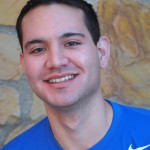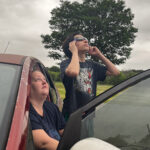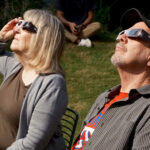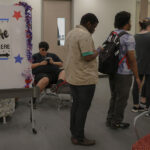By Brian Harrin and Michael Hernandez
Editor’s note:
Mesquite reporters Brian Harrin and Michael Velazquez put themselves in the shoes of San Antonio Police Department (SAPD) officers during a recent ride-along to get insight into their daily lives and learn about crime patterns on the South Side of San Antonio.
A ride-along sounds just like its name: a citizen goes on patrol with an officer for a designated shift and allotted time. The process involves submitting an official request, getting an officer to sponsor you and submitting a criminal background check. A lieutenant will then approve or disapprove the request and assigned an officer and shift.
With reporting team Harrin and Velazquez approved, the two choose the “T” shift to cover from 10:30 p.m. to 6:30 a.m. Arriving at the requested 30 minutes prior to the shift, the pair was told they would each be assigned an officer to cover a different zone on the South Side of the city.
Unfortunately for Harrin and Velazquez, their charged up cameras and equipment would not see any action as they were told no photography, video or recording would be allowed during the ride-along. The pair quickly learned that they faced a real dilemma and had to come up with a new game plan. The two resorted to doing old fashioned journalism — handwritten notes.
The following showcases each reporter’s take on the night and what they learned about the South Side of San Antonio surrounding their campus, Texas A&M-San Antonio.
Officers are not identified in this story, a requirement placed upon The Mesquite by the SAPD.
Brian’s take
The night started for me when I quickly learned that my officer preferred having both the driver and passenger windows rolled down, so I immediately regretted not wearing a jacket, as the temperature trickled down to the high 40s. My officer seemed to get a kick out of this and even asked if I wanted to borrow a jacket back at the substation.
My officer was very shy at first, but we both seemed to open up as the night progressed. First task of the shift was to head with a fellow officer for a java stop at the local corner store. I quickly learned the other officer did not like the service he was getting at this particular store, so off we trekked to another. The second time was the charm and both officers got a fresh cup of coffee, which would hopefully keep them alert for the next eight hours. What intrigued was the relationship the offices had with the store employees. They joked around with them calling them by name.
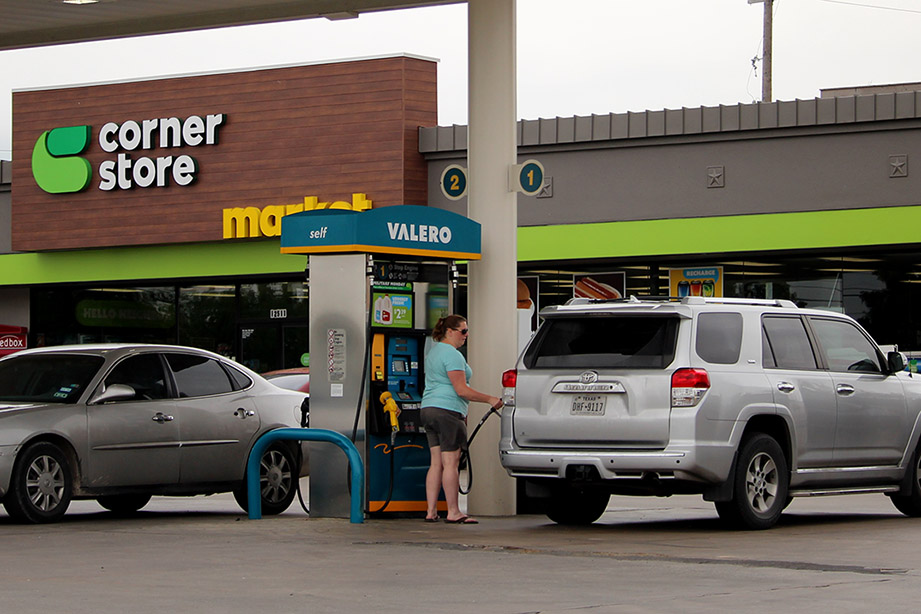
My officer had a keen ability to be very alert and notice everyone around him. He told me you never know what can happen and to always be prepared for the unexpected. Speaking of the unexpected, the employees at the corner store mentioned they had a “beer run” five minutes before we got there. A “beer run” sounds just like the name implies and can be stealing one beer or a case. The employees described the suspect and I learned that an officer has to file a report immediately preceding such an event. If caught, it encompasses a misdemeanor charge. We drove to a quiet church parking lot nearby and I observed the officer entering descriptions in his laptop in the center of the squad car.
At this point, the officer asked me about my academic and career goals. I touched upon my hopes of pursuing a career in intelligence for a government agency. In turn, I asked about his career goals too. He mentioned he’s working hard to pay off some bills straining his family of five. My officer has worked with SAPD for many years and hopes to pursue a hostage negotiation position with the department. I asked how he got his specific shift and he told me shifts are determined by seniority. The “T” shift works best for his family right now. He said it was not easy, as he gets maybe a couple of hours worth of sleep daily, and gets only a few days off per week.
After submitting the report, he showed me on screen that officers patrol different sections of a general area and cannot leave that section, unless a valid reason like an officer needs backup needs occur. It was also neat to see my fellow reporter’s squad car on the screen and which area he and his officer were patrolling in real time. At one point, my officer explained that if he was in danger, that I should press the red “emergency” button on the laptop. As I was sitting close to the screen, I inched a little closer to the door, as I did not want to “accidentally” touch that button and probably would be banned for life as far as ride-alongs go.
Next call involved responding to a “loud music” case and we rolled right along to a neighboring section. I was surprised to see another officer on the scene. As we approached the home, the decibels of the rock music grew louder and louder. My officer turned on his flashlight and the two checked out the house. Suddenly, a woman came out, appearing puzzled. Once presented with the situation, she told some guys to shut it down and to continue the party inside the home. As my officer gave her a warning sheet, she clearly wasn’t aware that if she does it a second time within six months, it could cost her a pretty $1,000 fine.
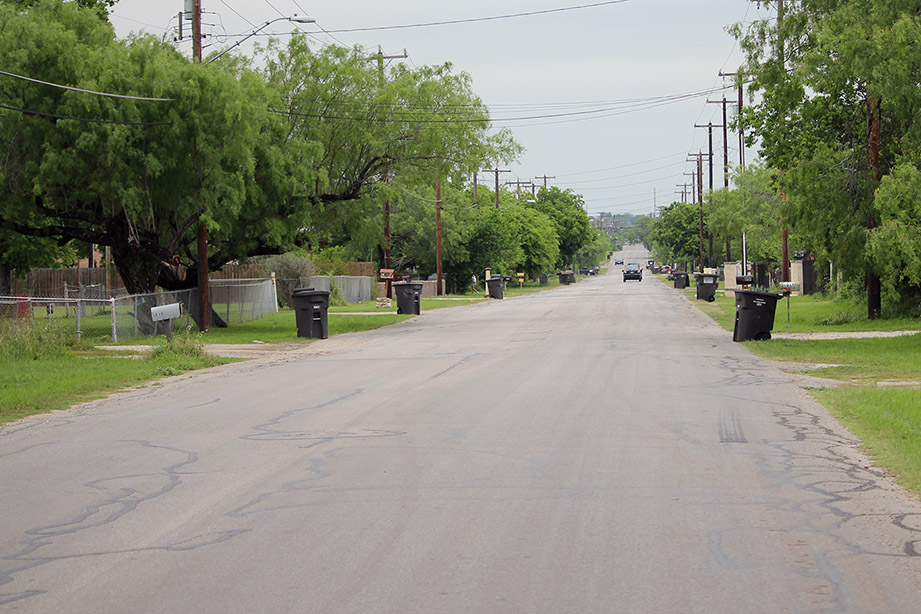
As we waited for the next call at the local Bexar County Tax Office, I asked my officer to talk about the most dangerous situation ever encountered as part of SAPD. He described a case where he was in pursuit of a suspect involved in a domestic disturbance. As the suspect stopped his Ford Econoline cargo van, he could barely see a silhouette reveal itself and he heard two loud shotgun shots, one barely missing his forehead. The suspect thought he had killed my officer and then quickly took his own life.
What intrigued me about his recollection was the fact that this was barely a cause for concern for my officer, as he had been hit with IED’s (improvised explosive devices) while serving in the United States Marines.
The next call was responding to a call from a towing yard where some young women were demonstrably upset that their car was towed. They argued they had permission to park but there was not too much we could do for them at this point. I felt the young woman just needed someone to vent to and my officer concurred with this thought. He really was effective at calming her down and making small-talk with her.
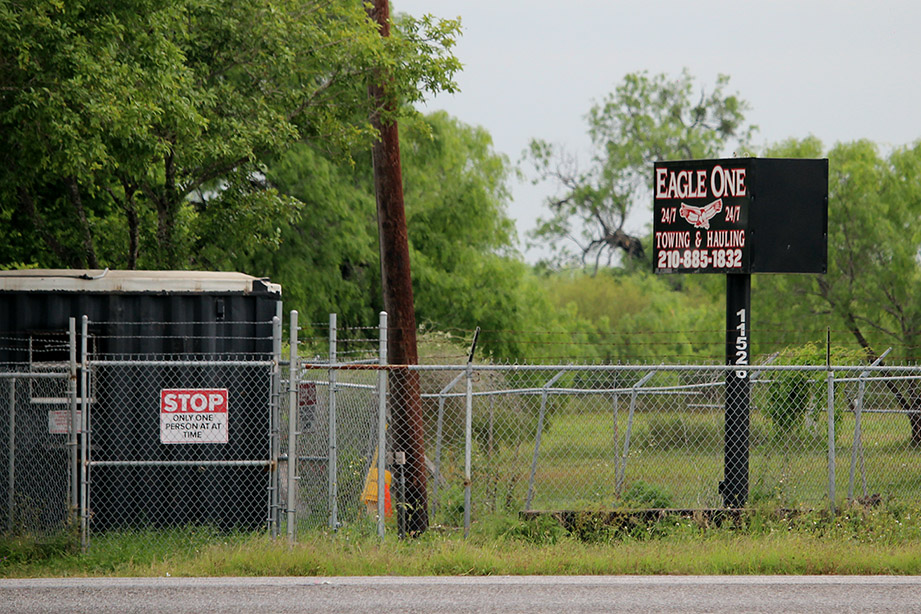
As the night rolled along, I was shocked to look at my watch and see the bright numeral two glowing in my face. Last call for me on the ride-along turned out to be the most interesting of the night. We responded to a domestic disturbance call involving two males. Upon arrival, I saw two other patrol cars already on the scene and was ready to watch out the window, when my officer said, “Let’s go!” Shocked, I quickly followed behind my officer into the small, dimly lit home. Once inside, I saw one man bleeding and a pool of blood on his carpet.
The other man was in custody and the officers were trying to determine what had occurred. Soon, the suspect was taken by an officer right in front of me and looked at me with the “who are you?” look. The man who was injured denied EMS and to press charges, much to the officer’s bewilderment.
I quickly learned that the suspect would be riding inches from me in our patrol car, separated by a metal divider. We were to drop him off at “home”, but little did we know “home” would be three different places. I joked with my officer that we were now an “Uber” for the time being. The suspect was describing his religious revitalization and how he is a good person all throughout the ride. We ended up dropping him off at the same corner store where our journey began for the night.
My officer could tell I was a little tired, as 3 a.m. approached, and we headed back to the substation to drop me off. The one major thing I took away from my experience is how hard these officers truly work, the need to be adaptable for any situation and how little activity there was near campus on a Friday night in the wee hours of the morning. As we approached my sedan, I thanked my officer for letting me tag along and off he rolled to the next call.
Michael’s take
My ride was scheduled for Friday April 1, April Fool’s night around loop 410 and Highway 90 and vicinity. A bit before the appointed time, I parked my car at the South Side police station parking and sat nervously chewing gum and staring at the time, awaiting for my scheduled ride along.
My heart was beating more noticeably than normal, not knowing what to expect. Finally my classmate and reporting partner Brian Harrin arrived and we went inside the building and approached the woman at the front desk. We spoke with her through the thick glass. After filling out more paperwork, having our license copied and waiting in the lobby, we were ready to start the night. It was time to get going.
My officer told me we were headed for the car. We got inside the cop car and I already had a plan in mind of what to do and ask, since we were told we could not record.
The first question I asked my officer was to describe the crime rate in the South Side. Since I live in the Northeast Side, I wanted to know if this area of the city is as dangerous as people make it seem.
To my surprise, he mentioned that was a bad perspective people have of the South Side. The South Side is actually safe and SAPD, he said, does a really good job keeping it that way. He also mentioned that the most dangerous part of San Antonio was the West Side. That’s where they have the most crimes involving shooting, murders, and narcotic arrests.
According to my officer, South Side crime mainly consists of domestic calls, intoxicated people at bars, and prostitution. Prostitution stood out to me. I was wondering, why in the South Side?
Southside prostitution is most prevalent between Presa and Roosevelt Streets, and surrounding areas. My officer took me by those places. There was not much going on that night. We did see a lady in a hoodie and the officer right away told me, “There is one right there.”

I was surprised. I asked him, how did you spot her so quickly and how do you know she is a prostitute?
“You just know, from working the area so long you recognize them, also by their body language. Their mannerisms can tell you right away,” he explained.
As we sped up and turned the car around to follow her, in less than a minute that it took us to turn around, she already had found someone and was taking him to a motel.
We were parking on the side curb as she and her companion make it inside the motel, it was too late.
I asked why is it too late. He said that once they are inside, there is nothing they can do. According to the officer, prostitution is due to trafficking and drugs, especially since San Antonio is so close to the border. According to SAPD.gov, incidents of prostitution decreased from 2015 to 2016 on the South Side. Panhandling increased while vandalism dramatically decreased.
My takeaway for the night? My ride along taught me that it takes a mentally strong person to do police work. I learned most police officers love what they do and find it rewarding helping their communities. Crime prevention is the foremost important job that the SAPD must maintain each and every day. They enforce the laws, order, and protect the public. Police officers are trying to make a difference in the world to make it a better place, one day at a time.

